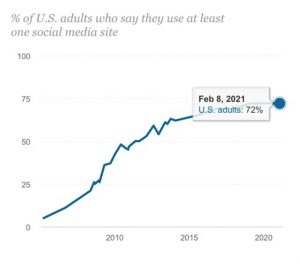Are Social Media Creators Using Us?
Iyanna Fairfax
Trending Writer

Favorite go-to apps such as Twitter, Instagram, YouTube, Facebook, and most recently, TikTok are among the biggest platforms out there. Over time, dedicated users have allowed these apps to be integrated as a habitual part of our personal, social, and professional lives. In fact, most people are not aware of the potential dangers that social media poses because there are so many enjoyable reasons to engage with the platforms. A statistic by the Pew Research Center stated that 7 out of 10 Americans use social media to “connect with one another, engage with news content, share information and entertain themselves”.
The number of options that users can access when it comes to how they share information is adapting with the demand of its audience, but how can these creators keep up with the trends and profit from the increase of users? The answer lies behind microtargeting and monetization.

Microtargeting is “a form of online targeted advertising that analyses personal data to identify the interests of a specific audience or individual to influence their actions” as defined by researchers from the Initial Coin Offering Organization of the UK. People in the tech world call this tactic, following our “digital footprint” to create the most appealing ads directly to the source.
Microtargeting has certain benefits, like having a personal feed, or needing a space to advertise a new business you may be creating. However, to provide a level of personalization to the media at a fast pace requires an immense amount of data. The information of the platform’s users is sorted through many channels and redirected to advertisers, which then find their way to your phone screen.
To monetize something is simply to convert it into money. In this case, it is our data that companies are profiting from. Advertisers can micro-target because these media sites sell user content directly. In a Forbes article, AI and Big Data researcher Kalev Leetaru defined what it means for social media platforms to sell our data. “Social media platforms often generate the majority of their revenue through selling hyper-targeted advertising based on algorithmically mining every second of their unwilling and unwitting users’ lives”. Based on his findings, media creators are taking data after practically all post activity, from dinner to family vacations, silly posts sent to friends, and everything in between.
Everyone is enjoying the apparent freedoms of the new media forms because it allows users to be expressive in ways that may not have been possible, but this new access comes at the expense of our personal data.
Although some policies and statements should protect customers, the users themselves are the product and their policies are even said to be dehumanizing. According to Leetaru, “the rest of the time they are dehumanized through the term “user” to remind us that we are merely data points and login accounts to Facebook, not real human beings whose lives are being exploited and monetized for its benefit.”
The term itself allows Facebook to refer to its audience as a user instead of a customer. So, they do not obligate themselves to show consideration for the data that is being sold. While there is still ongoing research on the mission of social media creators, their main goal is to profit. and have users on their platforms to collect the most amount of data and advertise various topics such as political agendas, pop culture, and fashion.
Contact Iyanna at fairfaiy@shu.edu

